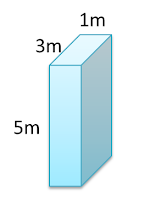In SPM, you need to know
- The definition of pressure
- The formula of pressure (you need this formula to do lot of calculation.)
- The SI unit of pressure
- Factors affecting the magnitude of pressure
Pressure
Pressure is defined as the force acting normally per unit area. (Here, the word “normally” means perpendicularly.)
Example
As shown in the diagram above, a 20N force acts on a 4cm² surface. The force is shared equally by the surface, hence each 1 cm² of the surface withstand a force of 5N (20N/4).
The force (5N) acts on 1 unit area (1cm²) is said to be the pressure acting on the surface. Therefore, the pressure acting on the surface is 5N/cm².
Unit of Pressure
The SI unit of pressure is Pascal (Pa). 1 Pa is equal to1 newton per metre2 (N/m²).
Factors Affecting the Magnitude of Pressure
Factors that affect the pressure acting on a surface.
- Magnitude of the force.
The larger the force, the higher the pressure. - Contact area.
The larger the contact area, the lower the pressure.
Finding the force acting on a surface when the pressure and surface area are given.
Example:
A force F is acting on a surface of area 20cm², produces a pressure 2500Pa on the surface. Find the magnitude of the force.
Answer:
This is a pretty direct question. We just need to write the formula and then substitute all the related value that we have into the formula and then solve it.
However, we need to be careful about the unit. If the pressure is in Pa, then the unit of area must be in m².
Example:
A block of wood 3 m long, 5 m wide and 1 m thick is placed on a table. If the density of the wood is 900 kgm-3, find
- the lowest pressure
- the highest pressure
on the table due to the block.
Answer:
a.
Step 1: Finding the weight of the block
The volume of the block = 3 x 5 x 1 = 15m³.
Mass = Density x Volume
Mass of the block, m = (900)(15)= 13500 kg
Weight of the block = mg = 13500 x 10 = 135,000N
Step 2: Determine the surface area
The pressure exerted on a surface is inversely proportional to the area of the surface. The bigger the surface, the lower the pressure.
For the wooden block, the biggest surface, A = 5 x 3 = 15m²
b.
The pressure is the highest when the surface area is the smallest.
The smallest surface area of the block = 1 x 3 = 3m²
Example:
Two cubes made of the same material; one has sides twice as the other, lying on a table. Standing on one face, the small cube exerts a pressure M on the table. What is the pressure (in term of M) exerted by the larger cube standing on one of its faces, on the table?
Answer:
For the small cube,
Surface area = x²
Volume = x³
Mass = m
Weight = mg
For the big cube,
Surface area = 4x²
Volume = 8x³
Mass = 8m (Because the volume is 8 times greater)
Weight = 8mg





